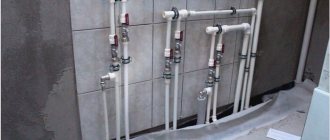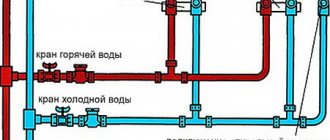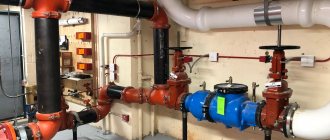When is it time to change the sewer riser?
The need to replace part of the riser arises in the following cases:
- A leak was detected.
- After purchasing a home in an apartment building (MCD), when the new owner decides to replace communications rather than wait for leaks to occur.
- Planned work.
In houses built in the middle and end of the 20th century, cast iron pipes were used in the construction of sewers. This material is reliable, but most of the objects were built a long time ago, and the communication networks have become old. Leaks often occur and repairs are required. It can be urgent, but most often the replacement is done as planned.
Who is obliged to change the riser
If the house is multi-apartment, part of the property of the residents is common. This applies not only to the riser, but also to the outlet from it. It is common until the first joint.
All issues related to the maintenance of property are discussed in the following documents:
- Government Decree. We are talking about document No. 491, which was released on August 8, 2006.
- Resolution of the State Committee for Construction No. 170, which considers the standards of technical operation.
- Manual released on April 2, 2004.
All work to replace common property in an apartment building must be carried out by a management company. The owner of the property or its tenant, in order to initiate their commencement, must draw up an application. It states the request, giving arguments why the riser needs to be repaired or completely replaced.
The company must consider the appeal received from the citizen and provide a response. The time when the work will be completed must be agreed upon. The property owner must be at home to provide the craftsmen with access to the premises.
The homeowner is not obliged to pay for the work of specialists and the materials used. If a representative of the management company demands payment, citing the fact that the riser is located inside the apartment, this is illegal.
At whose expense
You will only have to pay to replace the riser if the sewer system is working properly, but the property owner wants to replace the pipes. For example, the need for this may arise during the redevelopment of the premises or during a major overhaul. In all other cases there is no need to pay.
The riser belongs to the common property of the house, so repair work is carried out for money that is collected monthly for the maintenance of housing. If a social rental agreement was concluded, this means that the residential premises belong to the state. In such a situation, all funds will be taken from the municipal budget.
If the riser is replaced as planned, then the money is taken from the funds that the residents of the apartment building allocate for major repairs.
When can a tenant be denied pipe replacement?
The tenant may be denied a replacement riser.
Don’t think that the organization will immediately agree to a replacement.
She can refuse legally if the following is observed:
- The owner who submitted the application does not pay utilities. If he has debts, then replacing the riser will be postponed until they are fully repaid. The only exception is when an accident occurs.
- A work schedule has been approved, based on which repairs are planned for the house, but the property owner is going to replace the riser before the specified date.
- If the replacement was previously made by the homeowner, he bought the pipes himself.
The last point is important. If the owner of the apartment replaced the pipes, but did not coordinate this with the housing and communal services and there was no quality control, then the organization is not responsible for this section of the sewer system.
Legislative plane
To begin with, let us indicate that water supply risers are common property, which is clearly confirmed by law.
Thus, in the official Rules that determine the standards for the maintenance of multi-apartment buildings, equipment that simultaneously serves more than one apartment is included in the number of property that is considered common in the building. Using this designation, let's move on to another legislative norm. According to the first part of Art. 161 of the Housing Code, the managing body of an apartment building is obliged to ensure the uninterrupted functioning of all engineering communications that belong to the category of common property. But here it is important to note an important feature: the legislative norm only works in a situation where residents have entered into a formal agreement with the governing body and pay for its services.
That is, according to current legislation, you have the right to demand maintenance work from the organization that has assumed the responsibilities of managing your home: housing office, housing department, homeowners association, etc. But this only opens up the question of replacing the risers, so we move on.
Replacement of common building communications is the responsibility of public utilities
General rules for independently replacing water supply and sewerage pipes in an apartment
If you decide to do the work yourself, you need to do the following:
- Notify the company that manages residential buildings. This is done even if the property owner buys the materials himself and hires a craftsman at his own expense.
- Notify neighbors that it is planned to replace the riser.
- Turn off the water. Neighbors should be asked not to use the drain during repair work.
It is necessary to prepare the grinder in advance. It is needed to cut pipes. Connections between floors are opened using a hammer drill.
The following tools will be required:
- hacksaw;
- a piece of pipe of the required diameter and length with fittings for it;
- gas key No. 2 (2 pcs.);
- hammer;
- clamps.
To seal the cracks you will need a sealant.
When dismantling a pipe, place a bucket under it to prevent water from spilling onto the floor.
Contacting the management company
Now let's move on to the most interesting part - contacting the governing body that has taken over the function of servicing your home. For this organization, the main reason for replacing risers should be a statement from residents about the need for repairs. It should indicate the exact reason for the maintenance work. It is recommended to attach to the application:
- photographs proving the emergency or worn-out condition of the risers;
- an independent examination confirming the need for replacement;
- copies of receipts for payment for company services.
Payment for repairs is made by utility services
. As practice shows, all these documents speed up the application review process. But their absence is not considered a reason to refuse repairs. Also, the company cannot require you to conduct an examination at its own expense - it is performed solely at the request of the residents.
After reviewing the application, the governing body must respond in writing. If you receive an unreasonable refusal, you have three potential scenarios for further developments:
- write a complaint addressed to the head of the management company;
- contact your local housing authority;
- sue.
So, we looked at when apartment owners can apply for replacement of water supply risers at the expense of the management company, and when they will have to shell out their money. If common building risers need maintenance and the reason for the repair is not damage caused by your actions, you can safely use the proposed tools to request the necessary services: armed with legal norms, submit an application to the management company.
What is needed to replace a riser in an apartment with your own hands?
In houses built since the 50s of the 20th century, the toilet, bathroom and kitchen are located nearby. The first sewer unit is located under the sink, with a pipe coming from it. It passes through the bathroom, and in the toilet it crashes into a common riser.
Water containing waste goes into it. The pipes in the rooms are laid at a slight slope, so it moves by gravity. The pressure in the sewer system is not artificially increased. To prevent waste from stagnating in the pipes, when replacing parts of the sewer system, the degree of their slope should be controlled.
Which pipes to choose
If you need to replace the old riser with a plastic one, you can use the following pipes:
- metal;
- ceramic;
- polymer.
PVC pipes for internal sewerage.
Ceramic ones are expensive. The products are not afraid of the negative effects of aggressive chemicals, which is why such pipes are often installed in enterprises. But they are not needed in apartments.
Polymer pipes are lightweight. They are good because even after several years of service, growths do not appear on their inside.
There are products made from polyvinyl chloride and polypropylene on sale. The first material is durable, it is resistant to ultraviolet radiation, but when burned and strongly heated, it releases harmful substances. Sewage drains have a low temperature, so such pipes can be used.
Polypropylene has no such disadvantages. The products are easy to install; all the work can be done on your own. Pipes have a long service life and can withstand sudden temperature changes.
Metal pipes can be steel or cast iron. The former are distinguished by their strength and resistance to high temperatures. But steel is susceptible to corrosion, so such risers are not installed in apartments.
Products made of cast iron are more expensive than others, but among their advantages can be noted their resistance to corrosion. They are durable and will last for many years.
Among the disadvantages, we can note the large weight, so it will be difficult to install the riser. Cast iron pipes become overgrown on the inside, which reduces their permeability.
How to properly dismantle the riser
If the old riser is made of cast iron, you need to act carefully when dismantling. The material is fragile, so rocking the pipe and even light impacts on it can cause cracks or chips. Defects may appear in neighbors who did not replace the pipe with a new one made of PVC.
It is best to carry out the replacement simultaneously on all floors, but not all homeowners can be persuaded. In this case, you will have to change the pipe in your apartment.
It’s good if you can replace the riser in the section between floors. If this is not done, microcracks may appear in a section of the pipe that is inaccessible to apartment owners above and below.
If a leak occurs, neighbors may accuse the repairers of doing the work carelessly. For this reason, a leak occurred and property was damaged.
Who to complain to
Residents of the lower floors are interested in what to do if the apartment is flooded with sewage. Of particular concern is the question of who will compensate for expenses and losses incurred by residents through no fault of their own? The problem does not arise on its own; someone is to blame for the blockages. It can take a lot of time to find people who throw rags or diapers down the toilet, especially since their guilt still needs to be proven. However, after removing the blockage, you must draw up a damage report. This is done by technicians from the Criminal Code. With this act, an assessment of the damage is carried out, for which a special expert is involved. After this, you can go to court and demand compensation for losses from the management company. From now on, the search for the culprit of the leak will become the concern of management company employees, otherwise they will have to pay out of their own pockets.
Dismantling diagram
Dismantling begins by retreating 10 cm from the upper end of the pipe, and then making an incision. Stepping down 1 m from it, make another circular one, performing it in the form of a spiral. This is a precautionary measure so that the grinder disc will not jam. The worker will not be injured if the rebound occurs.
After this, take a hammer and chisel. The cut is tapped until the pipe bursts. If you do everything carefully, it will split along the cut line. If it is very rusty, it can be chipped off in parts.
When installing cast iron risers in old buildings, a caulking method was used or the pipe was fixed in a socket. Finding out how the pipe is held in place is easy. You need to hit it several times with a rubber sledgehammer, and then swing the riser.
An example of a sewerage diagram.
If you use carbolic acid, it will begin to fall out of the socket. If sulfur was used as fastening, blows with a sledgehammer will not budge it. In this case, you should take a blowtorch and start heating the pipe at the junction.
As a result of heating, the sulfur mass melts. The pipe is swung, held with pliers or an adjustable wrench, and then removed. The bell is cleaned of carbolic acid or traces of sulfur.
Sulfur fumes are poisonous, so you cannot work without a gas mask. After dismantling is completed, the room must be ventilated.
Part of the pipeline is the tee socket. It is required to connect the sewer pipe running from the kitchen to the toilet with a riser. It is most convenient to install tees made of plastic. To prevent leaks, all joints are coated with sealant.
Who carries out the work
Some owners mistakenly believe that if the internal pipes are used by the residents, then changing the system rests solely with them. Lack of knowledge of standards leads to unnecessary waste of money.
Question:
Are risers inside an apartment considered personal or common property, and where can I find out the cost of the service?
Answer:
Based on Government Decree No. 491, only pipe bends from risers are considered personal property, and, as a result of this fact, the entire responsibility for maintenance and elimination of defects rests with the owners of residential premises. Payment is also made from your own funds.
Payment receipts for housing and communal services include the column “House Maintenance”. It implies that the housing office or homeowners association must take measures to eliminate faults in the water supply system and maintain it in working condition.
Thus, if a pipe breaks or deforms, the management company does not charge a fee to the apartment owner. Otherwise, this is a violation of the Housing Code of the Russian Federation, which threatens administrative sanctions for the management of the HOA.
How to assemble a new riser
The new riser is assembled from the bottom up. All sections are polished, removing burrs. This is done to prevent uneven surfaces from becoming debris collecting areas. Fasteners are installed under the sockets; clamps are used for this. The riser is fixed to the wall.
If polypropylene products are installed, use a compensator (pipe). It is put on a cut of an old pipe. At the final stage, the straight section is connected to the pipe. The pipe may not fit well into the socket; in this case, its edge is lubricated with soap.
When the installation work is completed, all joints are carefully coated with sealant.











